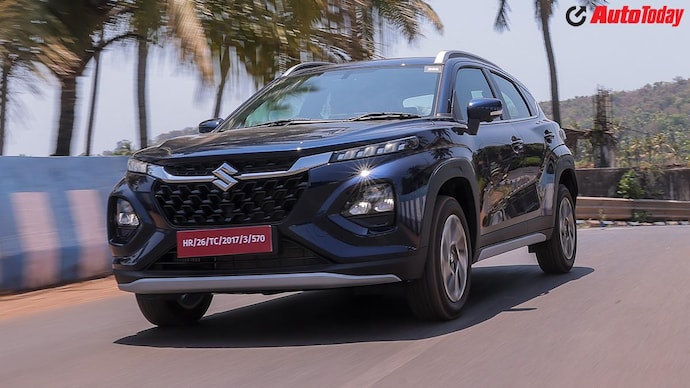Maruti Suzuki is out with a new car, clearly defining it as a compact SUV. It’s based on the outgoing Baleno hatchback but is it really any different? We drove the new Fronx in Goa ahead of its launch to find out just that.

Maruti Suzuki Fronx driven ahead of its launch.
By Abhik Das: The unusual name, Fronx, almost seems like Maruti Suzuki ran out of imagination while conceptualising it. The name I presume, is a derivative from its classification as a front-wheel-drive crossover but once past the name though, a quick glance at the car makes it easy to see where all the imagination went. A truly handsome looking compact-SUV that makes its purpose very evident.
advertisement
You see, the Grand Vitara right now, sits atop the Nexa portfolio as the brand’s flagship SUV debuting a strong-hybrid powertrain and focusing on meeting the increasing demands of the form factor as well as high fuel efficiency needs. Focusing on the former requirement, the SUV form factor is what far supersedes demand for any other type of car, especially in a segment of cars that caps off under the Rs 15 lakh mark. Relatively smaller footprint, champions the urban jungle, is fuel efficient, feature-rich and adds a dash of premium to complete the recipe for a compact-SUV that the Fronx is. For Maruti, this meant retaining a family face from its premium SUV thus explaining the easily recognisable styling of the Fronx.
Bold front fascia with the three-dot signature DRLs, low-mounted LED headlamp, stylish grille and skid plate give the car a dominant front-end. It’s the sides that reveal the Baleno hidden cleverly in the design, with the ORVMs and doors identifiable from the hatchback. While the rear again, continues with the Grand Vitara inspired styling cues made prominent by the LED tail-lamps and a smart-looking illuminated lightbar running across the width of the rear hatch. The square wheel arches, rear skid plate and claddings on the sides complete this easily likeable design that looks very handsome.
Once inside the cabin, the space feels absolutely familiar being a straight lift from the Baleno and an opportunity to re-emphasise on the cliche, why fix it if it ain’t broke. Good quality materials and upholstery aside, the interior does offer room for four adults easily with scope of a fifth passenger fitting into the rear seat. The features get carried forward too so seamless connectivity through a 9-inch touchscreen and SmartPlay Pro+ infotainment, automatic climate control, an HUD, 360-degree camera are all available in the top-end trim while even adding a wireless charger into the mix.
On the road, the Fronx again has a sense of familiarity in the way it drives as it shares the underpinnings of the Heartect platform-based Baleno. An option of the smooth 1.2-litre, naturally aspirated, K Series petrol engine paired with a 5-speed manual or AMT would further enhance that feeling but if one were to truly treat this car as a new iteration, it’s the 1.0-litre turbo-petrol motor that should be of interest. The Boosterjet makes a comeback after featuring in the Baleno RS briefly and was consequently discontinued due to high import costs. Maruti has taken its time to localise the engine as its competitors were already utilising similar engines in various cars. So 100bhp and 148Nm in a hatchback is always going to be exciting especially if the power delivery is staggered and that’s afforded by the turbocharger. Power comes in post 2,000rpm after a bit of lag off-the-line but once on the boil, the motor then builds boost till 3,000rpm where it really comes alive. 3,000-5,000rpm is where the meat of the power lies which in day-to-day usage translates to a solid mid-range if the gearbox is worked with accordingly. The 5-speed manual we drove in the narrow roads of Goa demanded frequent downshifts than usual but it didn’t take away from the excitement that the tiny but powerful turbo-petrol brings along. The 1.2-litre is extremely fuel efficient with the Smart Hybrid aka start-stop system that should also benefit the Boosterjet engine but expect slightly lesser overall fuel efficiency numbers than the 1.2-litre NA engine.
We got a taste of the 6-speed torque converter automatic transmission, that’s a second option with the engine, on a dedicated off-road course. The course didn’t present much of an opportunity to gauge the gearbox’s performance due to its tight nature but the shifts were smooth and timely. The Fronx Canvas as Maruti calledthe course, showcased the stiffness of the monocoque architecture as well as the stiffened suspension and the more than generous, 190mm of ground clearance that the Fronx rides on. 20mm over the Baleno which in our long term tests, was adequate for our road conditions, now makes the Fronx an even more capable performer when one runs out of roads entirely. So much so that in our hunt for shoot locations, massive road variations that would easily scrape the underbelly of regular hatchbacks, were dealt with relative ease. Outside of 4x4 intensive terrain, the Fronx shouldn’t have any problems taking one off the beaten path. The chassis’ stiffness coupled with a light and reactive steering helps the car rotate very easily around tight turns while the suspension, though stiff, still manages a comfortable ride quality that’s versatile enough to tackle rough roads as well as smooth, flowing tarmac without upsetting the occupants or displaying excessive body-roll.
Verdict
Having driven the Fronx ahead of its official launch, we reason the pricing to overlap the Baleno albeit with a premium yet undercut the Brezza which the Fronx also shares space with in the segment. More choices are always welcome and the Fronx should see a younger, more premium customer who may not necessitate the added space in the Brezza. The Fronx isn’t rewriting the rules or setting new benchmarks in any respect but it sure brings Maruti Suzuki in a very competitive space going up against the likes of the Hyundai Venue and Kia Sonnet among others. Good-looking, adequately spacious and feature-laden, choice of engines and transmissions, exciting Boosterjet engine and massive ground clearance, there are many things that the Fronx gets right and clearly distinguishes itself from the car it’s based upon.
SPECIFICATIONS
Engine - 1.0-litre, 3-cyl, turbo-petrol
Power - 100bhp@5,500rpm
Torque - 148Nm@2000-4500rpm
LxWxH - 3995x1765x1550
Wheelbase - 2520mm
Boot Space - 308 litres
Fuel tank - 37 litres
Price - Rs 7.5 lakh - Rs 11.5 lakh est., ex-showroom
--- ENDS ---
2023 Maruti Suzuki Fronx review, first drive - India Today
Read More

No comments:
Post a Comment